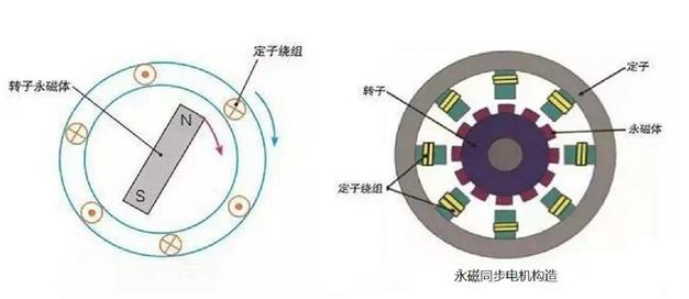
news
structure diagram and characteristics of permanent magnet synchronous motor
2023-04-27 08:43:49来源:
the structural diagram of a permanent magnet synchronous motor is shown below, which, like traditional motors, mainly consists of a stator and a rotor.

the stator is basically the same as the stator of an asynchronous motor, consisting of a stator core and armature winding. the stator core is generally made of 0.5mm silicon steel lamination and lamination. for high-efficiency indicators or high-frequency motors, in order to reduce iron loss, 0.35mm low loss cold rolled non oriented silicon steel plate can be considered. the stator winding generally adopts distributed short distance winding; for motors with a large number of poles, fractional slot windings are generally used; when further improvement of the potential waveform is needed, sinusoidal windings or other special windings can also be considered.
the rotor mainly consists of a permanent magnet, a rotor core, and a shaft. among them, permanent magnets are mainly made of ferrite permanent magnets and neodymium iron boron permanent magnet materials; depending on the magnetic pole structure, the rotor core can be made of solid steel or steel plates or silicon steel plates. compared with ordinary motors, permanent magnet synchronous motors must also be equipped with a rotor permanent magnet position detector to detect the magnetic pole position, thereby controlling the stator current and achieving the purpose of driving and controlling the permanent magnet synchronous motor.
according to the ac waveform of the input motor terminal, permanent magnet brushless motors can be divided into permanent magnet synchronous motors and permanent magnet brushless dc motors. the input permanent magnet synchronous motor is an ac sine wave or approximate sine wave, and the steering is controlled by a continuous rotor position feedback signal; the input permanent magnet brushless dc motor is an ac square wave, and the steering is controlled using discrete rotor position feedback signals.
according to the different positions of permanent magnets on the rotor, the magnetic pole structure of permanent magnet synchronous motors can be divided into external and internal types. the structure of an external permanent magnet synchronous motor is simpler than that of an internal motor, which has the advantages of easy manufacturing and low cost. therefore, it has been widely used in industry. among them, the rotor structure of the external permanent magnet synchronous motor is the simplest. compared to the built-in motor, it increases the average magnetic density on the rotor surface and can achieve greater electromagnetic torque. at present, external permanent magnet synchronous motors are the most widely used motors in industry.
the structural characteristics of permanent magnet synchronous motors are as follows:
the rotor of a permanent magnet synchronous motor is equipped with a permanent magnet, forming a permanent magnetic field. the structure can eliminate excitation loss and improve mechanical efficiency.
the rotor of a permanent magnet synchronous motor is usually made of hard magnetic steel, which has high magnetic density, stable magnetic properties, and can provide a strong magnetic field.
the rotor and stator of a permanent magnet synchronous motor are separated by air gaps, which are very small and can reduce mechanical noise and vibration.
the stator of permanent magnet synchronous motor usually adopts three-phase winding, which generates rotating magnetic field through ac power supply and interacts with the permanent magnet on the rotor to realize the rotating movement of the rotor.
the control circuit of permanent magnet synchronous motors usually adopts advanced control algorithms such as vector control and direct torque control, which can achieve high-precision and efficient operation control.
permanent magnet synchronous motors have a simple structure, high reliability, high energy density, and high efficiency, and are widely used in industries, transportation, military, and other fields.
